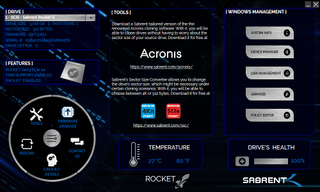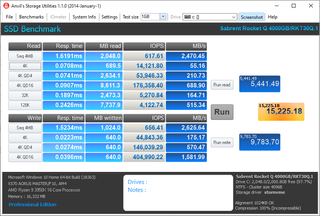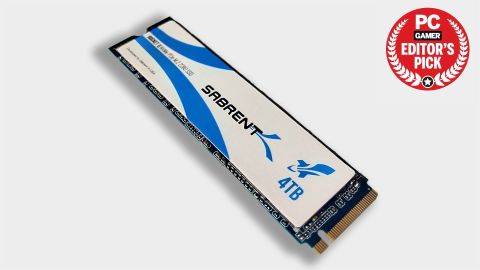Our Verdict
Sabrent's huge 4TB NVMe SSD offers loads of super fast storage in a tiny package. It's expensive for sure, but for once you really do get what you pay for.
For
- Consistently strong performance
- Capacity to spare
- 5 year warranty
Against
- Not exactly cheap
PC Gamer's got your back
The 4TB Sabrent Rocket Q NVMe is one of the largest NVMe drives you can buy right now, though that claim to fame is about to be eclipsed by a drive twice as big from the same company. From the same family in fact. That's right the Sabrent Rocket Q 8TB NVMe SSD is on the way, which pretty much rips up the original intro I had in mind.
Capacity - 4TB
Controller - Phison E12S
NAND - Micron QLC
Rated seq. read - 3,200MB/s
Rated seq. write - 3,000MB/s
Warranty - 5 years
I was going to start by talking about how storage keeps getting bigger and faster, and that we've come so far etc. The truth is, storage is moving at such a pace now, that the moment you think you've got the biggest and best, you can be sure something even bigger, even faster, or both is on the way. And that's before we even consider what the speedy storage in the Sony Playstation 5 is going to do to revolutionise the market.
The good news is that here on PC Gamer we don't look at technology for its own sake, it has to offer a benefit. In the case of this SSD, the hard benefit is the four terabytes of super fast NVMe storage exists in something the size of a stick of gum. Indeed the only thing that stops my jaw dropping to the floor is the knowledge of that 8TB version on the way. My jaw is still flapping around a bit regardless.
| Model | SB-RKTQ-1TB | SB-RKTQ-2TB | SB-RKTQ-4TB |
| Capacity | 1000GB | 2000GB | 4000GB |
| NAND | Micron 96 layer QLC | Micron 96 layer QLC | Micron 96 layer QLC |
| Controller | Phison PS5012-E12S | Phison PS5012-E12S | Phison PS5012-E12S |
| Max Sequential Read | 3200 MB/s | 3200 MB/s | 3200 MB/s |
| Max Sequential Write | 2000 MB/s | 3000 MB/s | 3000 MB/s |
| Random 4K QD32 (IOPS) Read | 125K | 255K | 550K |
| Random 4K QD32 (IOPS) Read | 500K | 670K | 680K |
| Warranty | 5 years with registration | 5 years with registration | 5 years with registration |
| TBW (Terabytes Written) | 260 | 530 | 940 |
The reason Sabrent has managed to hit such a high capacity is down to the use of QLC memory, a level of NAND flash designed with high capacity drives in mind. Quad Level Cell flash memory has been around for a little while now, and is the next logical step on from TLC (Triple-Level Cell) flash, and essentially each cell holds four bits of data as opposed to three (TLC), two (DLC) or the original one (SLC).
The benefit of QLC is capacity, each cell can hold more data and thus the drive itself can hold more. There is a downside though, and this is that writing to the cells takes longer (they tend to be slower than TLC drives), and the endurance isn't as high as TLC drives either. That lower durability is offset somewhat by how capacious this drive is; it's probably going to take you a long time to fill up this 4TB model.
Sabrent does offer a healthy five year warranty for the drive, although you do have to sign up to the extended warranty to get the most from this. And you only have 90 days to do so from the day of purchase, something that is definitely worth doing.
Even so, Sabrent quotes 940 TBW (Terabytes Written) for this 4 TB drive, which equates to 527 GB of writes per day over the five year warranty, which is considerably more than anyone would write under normal circumstances (not impossible, but pretty unlikely).

Sabrent provides a link to Acronis True Image with its drives, which will make transferring your existing system to the drive easier, if you don't see this as a good opportunity to install Windows afresh anyway. You can also download the Sabrent Toolbox from the official site, which provides SMART monitoring information, readouts of the drive's current temperature, as well as looking after things like firmware updates.
The temperature monitor side of the drive can be useful, as the Rocket Q can get warm in use. During the PCMark 10 storage tests it reached a peak temperature of 62°C (142°F), which isn't anything to get too alarmed about, especially if you've got good ventilation in your system, but it is something to be aware of. Note that it doesn't come with a heatsink of its own, but the Gigabyte X570 Aorus Master used for testing does have a heatsink over the M.2 slot.
It's a small thing, but the fact that the Rocket Q ships in its own little tin won me over a little before I even got it near the test rig. It doesn't affect the review, but it does feel like you're getting something that has been lovingly crafted, as opposed to just thrown together. Of course I'm not quite sure what you're supposed to do with the tin after you've bought it, but that doesn't detract from the whole box opening experience.
The Rocket Q NVMe drive uses the popular Phison E12S controller and Sabrent has paired it with Micron QLC memory. These are both well respected components, and together they should make for a decent little drive. And sure enough, the performance we've seen in testing is impressive.




The synthetic benchmarks produced good sequential read and writes of 2.9GB/s and 2.8GB/s respectively. These may not challenge the best NVMe SSDs, such as the Samsung 970 Evo Plus or the WD Black SN750, but they're not far behind. This is a PCIe Gen 3.0 drive mind, so it can't compete with the raw throughput of the Gen 4 drives, like the Corsair MP600, which can hit almost 5GB/s.
Performance in the 4K random tests was more impressive, and here the drive managed figures at the top of the benchmarking tables. This is a bit of a surprise for a QLC drive, although the fact that this is a fully populated controller, while the others are smaller 1TB drives helps explain this to a degree—throughput goes up as more of the controller's channels are populated (which is why smaller, more-affordable NVMe drives boast lower performance).

This strong performance carried over to the real world test of transferring 30GB of data across the drive (a mixed file type Steam install), which it managed in two minutes and 19 seconds, which equates to 221MB/s and puts the Rocket Q at the top of our benchmarks. It may only be a few seconds faster than the other drives tested, but that's still an impressive lead for what is supposed to be a slower technology.
Overall then, the 4TB Sabrent Rocket Q NVMe SSD is one of the most impressive NVMe SSDs you can buy right now. Yes, it's expensive, but it's so big you can forget about installing games on a slower data drive, and just enjoy top performance pretty much all the time. And if your budget can't quite stretch to this, it's impressive enough to suggest that the 2TB drive (for £220/$280) should be a good buy as well.
Sabrent's huge 4TB NVMe SSD offers loads of super fast storage in a tiny package. It's expensive for sure, but for once you really do get what you pay for.
Alan has been writing about PC tech since before 3D graphics cards existed, and still vividly recalls having to fight with MS-DOS just to get games to load. He fondly remembers the killer combo of a Matrox Millenium and 3dfx Voodoo, and seeing Lara Croft in 3D for the first time. He's very glad hardware has advanced as much as it has though, and is particularly happy when putting the latest M.2 NVMe SSDs, AMD processors, and laptops through their paces. He has a long-lasting Magic: The Gathering obsession but limits this to MTG Arena these days.
